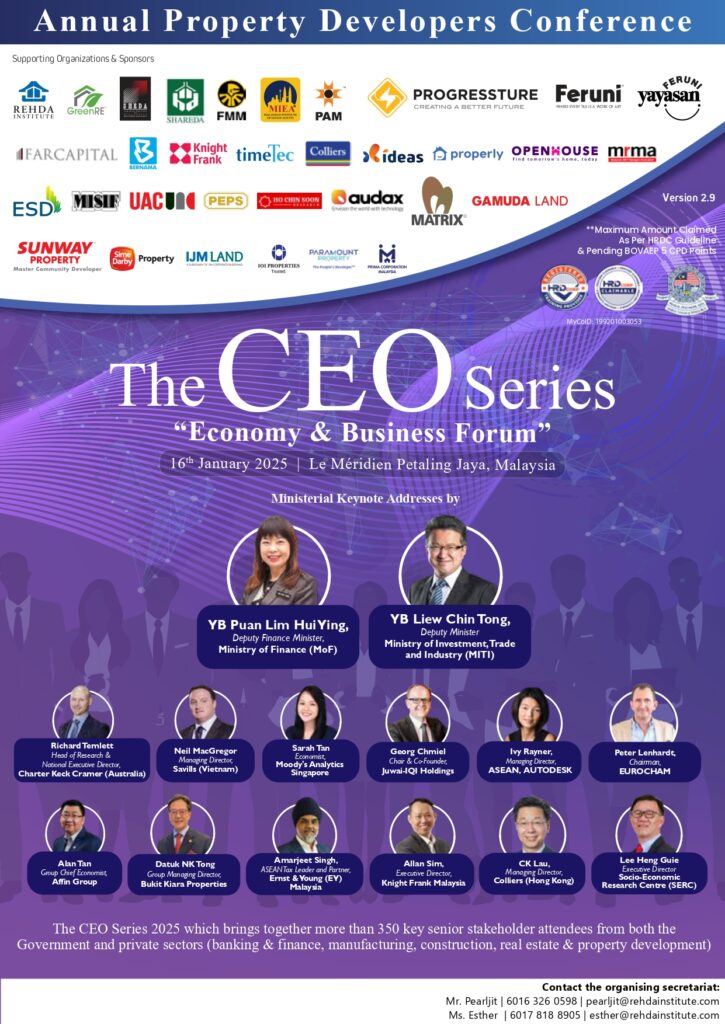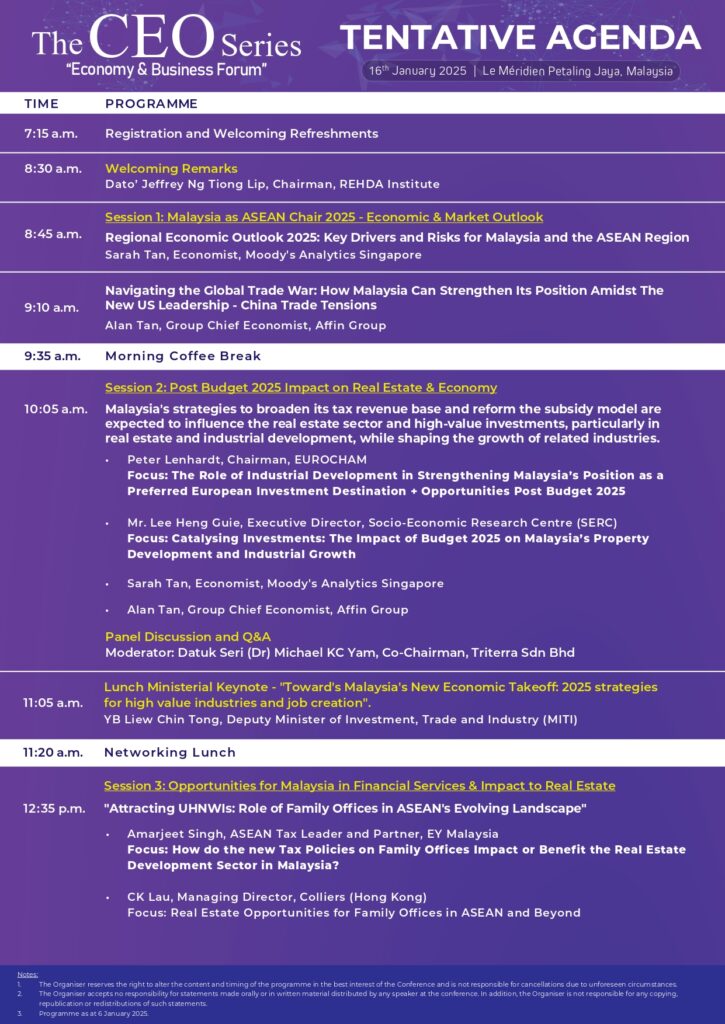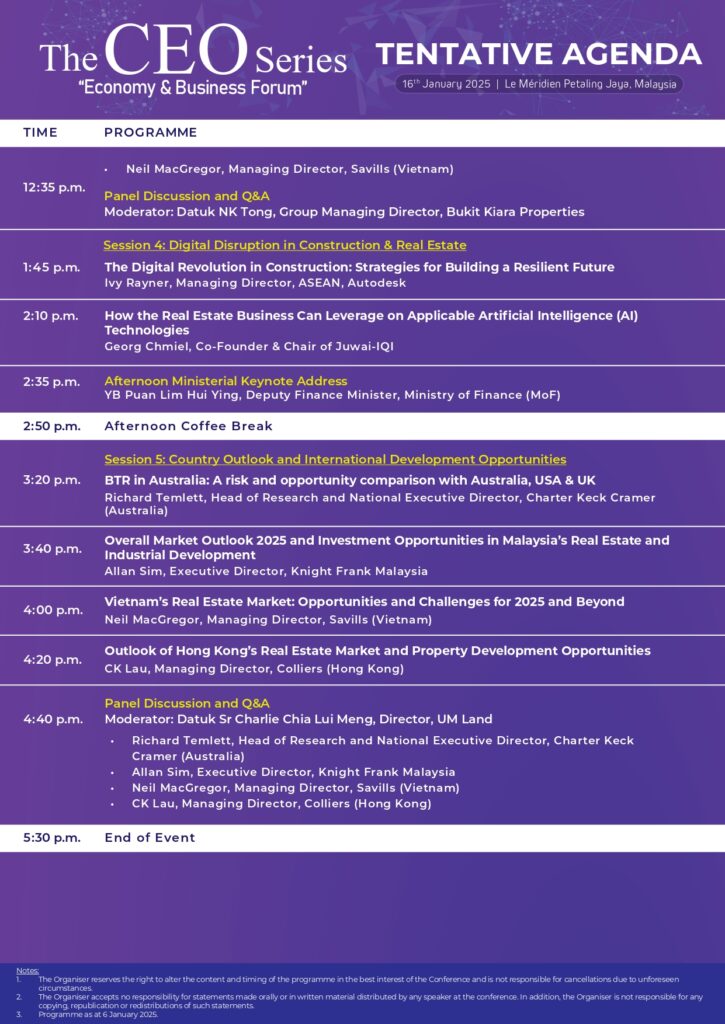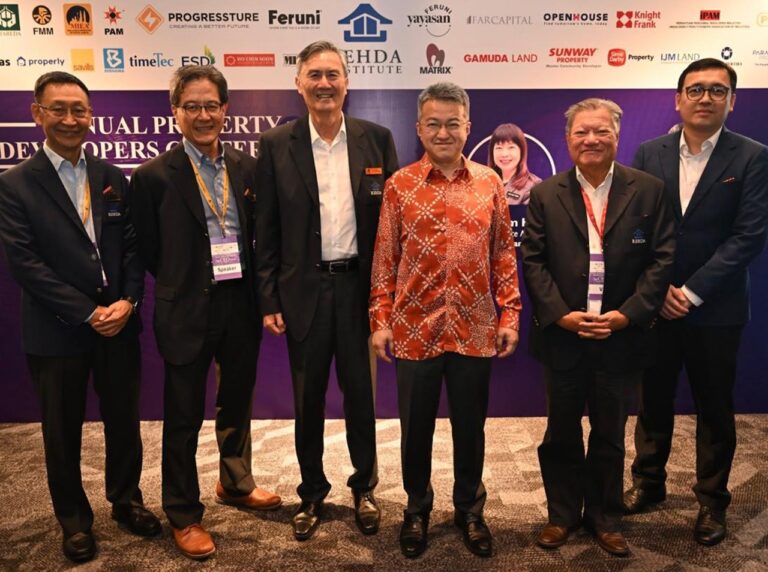
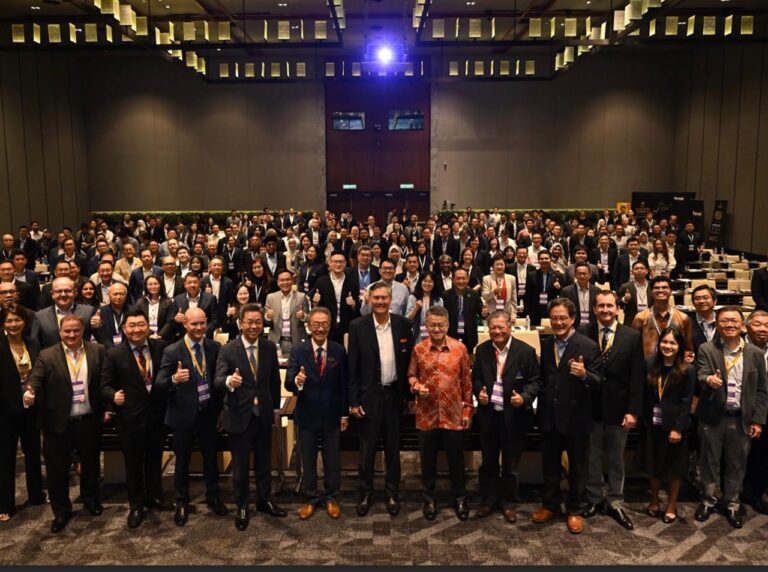
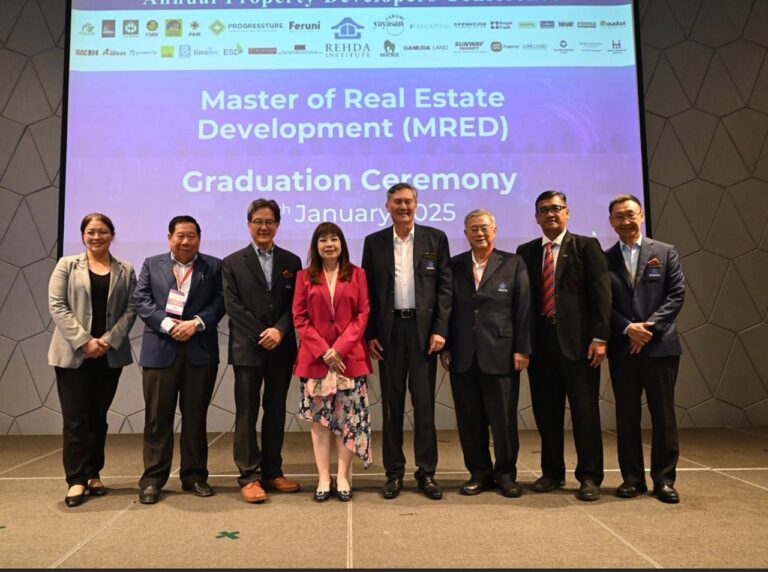
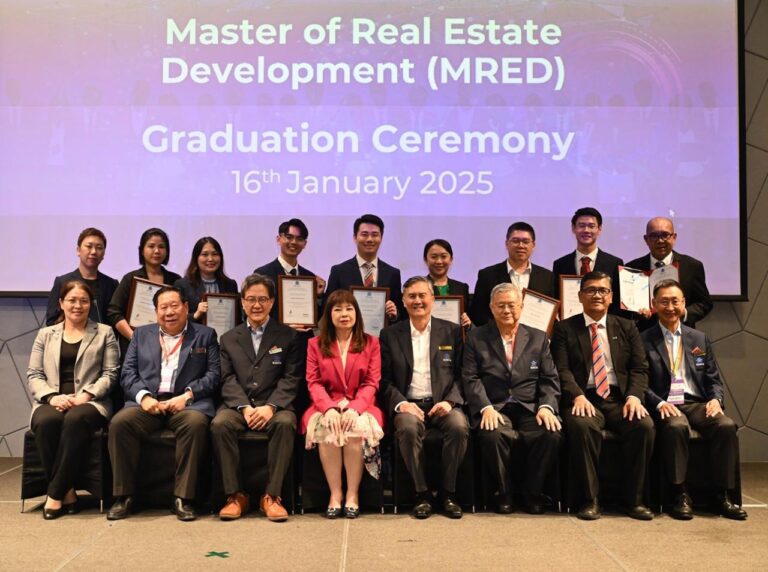
Keynote Address for CEO Series (Annual Property Developer’s Conference)
YB Puan Lim Hui Ying (Deputy Finance Minister)
YBhg. Dato’ Jeffrey Ng Tiong Lip, Chairman of REHDA Institute;
YBhg. Datuk NK Tong, Immediate Past President, REHDA Malaysia;
CEO Series 2025 Organizing Committee;
Distinguished Speakers and Delegates;
Members of the Media;
Ladies and Gentlemen.
Good afternoon and Salam Malaysia Madani.
1. First of all, I would like to express my gratitude to the organising Committee for inviting me to deliver the afternoon keynote address for the CEO Series (Annual Property Developer’s Conference) 2025.
2. As Malaysia progresses under the principles of good governance outlined in the Malaysia MADANI concept, the sharing of knowledge, information, and learning is crucial. These efforts align with Malaysia’s vision of becoming a sustainable, developed nation.
3. It’s great to see many association stakeholders and foreign speakers here, including foreign credit rating agencies like Moody’s. We believe this conference will positively position Malaysia in the eyes of global investors for 2025, supporting our Prime Minister’s agenda, especially as Malaysia chairs ASEAN in 2025.
4. Platforms like the CEO Series foster positive engagement between the Government and various industry stakeholders, allowing for feedback on policies. Since 2016, the CEO Series has been a key event across sectors such as construction, banking, fund management, hospitality, retail, manufacturing, and property development, garnering significant media coverage.
5. Malaysia’s current Budget 2025 (the third MADANI Budget) has been well received and includes several key initiatives to attract investments, among others:
• New Investment Incentive Framework (NIIF): RM1 billion ($228 million) in incentives to attract foreign investments in high-value activities, expected to launch in Q3 2025.
• Investment Incentive Framework (IIF2025): Aimed at modern services in AI, robotics, IoT, data science, and FinTech.
• Tax breaks for MNCs: Encouraging MNCs to invest in Malaysia and strengthen local supply chains.
6. Additionally, on 7th January 2025, a new agreement on the SEZ was signed at the 11th Malaysia-Singapore Leaders’ Retreat, offering further incentives for investments into the Johor-Singapore Special Economic Zone (JS-SEZ). The JS-SEZ spans 3,571 sq. km across southern Johor, four times the size of Singapore, and includes nine flagship zones: Johor Bahru City Centre, Iskandar Puteri, Forest City, Pengerang Integrated Petroleum Complex, Tanjung Pelepas-Tanjung Bin, Pasir Gudang, Senai-Skudai, Sedenak, and Desaru.
7. Among key JS-SEZ incentives are, special 5% tax rate for 15 years on qualifying manufacturing and services activities, including AI, quantum computing, medical devices, and aerospace, as well as eligible knowledge workers will enjoy a 15% income tax rate for 10 years.
8. Building on the Malaysia-Singapore cooperation, the JS-SEZ incentive package aims to attract high-value investments, create higher-income jobs, and solidify Johor as a regional economic hub. The competitive tax rates make it an attractive destination for professionals in advanced sectors.
9. As a training, research and education organisation, I have been informed that REHDA Institute has MoUs with universities like University Malaya, Monash University, Sunway University, and UTAR, as well as BPMB for research and education.
10. The MRED program is Malaysia’s only master’s focusing on property development, with guest lecturers from industry leaders and scholarships offered by REHDA. Later today, I’ll have the honour of witnessing MRED graduates receive industry certifications and awards.
11. These initiatives align with the United Nations Sustainable Development Goals (UNSDG), specifically with Goal 4: Inclusive, quality education and lifelong learning, Goal 8: Inclusive and sustainable economic growth and decent work and Goal 9: Resilient infrastructure, sustainable industrialization, and innovation.
12. I commend REHDA Institute for its contribution to the nation by partnering with universities to ensure programs are industry-relevant. I hope more partnerships, especially research collaborations, are formed to enhance universities’ capabilities, improve graduate readiness, and raise university rankings.
13. Looking ahead, I am optimistic about Malaysia’s property development sector. Let’s continue to collaborate—government, industry, and academia—to build a sustainable future for our nation.
Thank you.
————————–
Speech for Dato’ Jeffrey Ng Tiong Lip
- Bhg Datuk NK Tong, Immediate Past President, REHDA Malaysia;
- REHDA Institute Trustees and REHDA National Council Members;
- CEO Series 2025 Supporting Organisations and Sponsors;
- Distinguished Speakers and Delegates;
- Ladies and Gentlemen.
- On behalf of the organizing team and supporting organizations, I welcome all of you to the CEO Series 2025 (Annual Property Developer’s Conference). This forum serves as a crucial platform for senior management from various industries, association stakeholders, and policymakers to exchange insights and shape the future of Malaysia’s real estate and economic sectors.
- We are honoured by the presence of esteemed international speakers from Australia, Hong Kong, Vietnam, and Singapore, in addition to the speakers and moderators from Malaysia. I am pleased to note from the team that we have an excellent turnout of close to 400 delegates today.
- As we embark on 2025, Malaysia’s economy stands at a pivotal moment. The global landscape remains shaped by persistent geopolitical uncertainties and the ripple effects of the past years’ economic challenges. However, the resilience of our domestic economy offers optimism. The global GDP growth forecast by the OECD indicates modest improvement at 2.9% in 2025, signalling opportunities amidst ongoing challenges. Domestically, Malaysia’s GDP growth is projected to rebound to 4.5% in 2025, driven by improved external demand and strategic policy interventions. Additionally, the ASEAN region is expected to grow at an average of 5.2% in 2025, underscoring its role as a dynamic economic bloc under Malaysia’s 2025 chairmanship.
- In terms of Global Economic Trends, Malaysia remains deeply interconnected with the global economy. Sustained trade relationships, especially with Singapore, China, and the United States, continue to anchor our economic stability. Bilateral trade within ASEAN is also expected to exceed USD1.3 trillion, supported by initiatives such as the Regional Comprehensive Economic Partnership (RCEP).
- With reference to Malaysia domestically, our current Madani Government under the leadership of our Prime Minister has renewed emphasis on high-value industries and digital transformation, continuing to chart a progressive course for our economy. Initiatives under the National Energy Transition Roadmap (NETR) and National Industrial Master Plan (NIMP) 2030 aim to position Malaysia as a regional leader in innovation, sustainability, and renewable energy. I believe some of the above will be elaborated and discussed by our speakers and panellist today.
Ladies and Gentleman,
- In terms of key opportunities, Malaysia looks well-poised to capitalize on several growth opportunities in 2025:
6.1 Johor-Singapore Special Economic Zone (JS-SEZ)
In my welcome address in CEO Series 2023, I have previously highlighted that I believe Johor will be the state to watch.
In the recent Malaysia-Singapore Leaders’ Retreat on January 7, 2025, the JS-SEZ is expected to attract investments exceeding USD15 billion by 2030, focusing on advanced manufacturing, green energy, and digital technology sectors. The SEZ is anticipated to create 20,000 high-value jobs by 2027, positioning Johor as a gateway for global investment into ASEAN, which will have a positive spillover effect on the overall economic development.
In addition, Johor Forest City’s designation as a Special Financial Zone (SFZ) brings additional tax incentives, including a reduced corporate tax rate of 15% for qualified investors and businesses. These policies are designed to attract global corporations and family offices, reinforcing Johor’s role as a potential hub for international investment.
- Embracing the Digital Economy
The rapid growth of smart cities and digital infrastructure is redefining Malaysia’s business landscape. Developments in AI, blockchain, and IoT are facilitating the evolution of future-ready urban ecosystems. Malaysia’s digital economy is projected to contribute 25.5% to GDP by 2025, in line with the goals of MyDIGITAL.
- Johor’s Growth and Property Market Outlook
In last year’s CEO Series, I highlighted Johor as the state to watch. A year later, we’ve seen major developments, with significant announcements made in collaboration with the Singaporean government. Here are three key observations:
- Johor’s Continued Momentum
Johor’s business momentum will continue to thrive, with the property market poised for significant growth, especially compared to Singapore’s property prices. This growth is supported by the increasing number of public listed property development companies in the JS-SEZ, whose market capitalisation has doubled, reflecting strong private sector confidence. Additionally, Johor’s infrastructure investments and the influx of FDI will benefit not just Johor but the broader Malaysian economy.
7.2 Property Market Recovery
The property market is showing clear signs of recovery. From 2010 to 2014, the Developer Interest-Bearing Scheme (DIBS) boosted the market, leading to strong project launches. However, when DIBS was removed in 2014, the market slowed down, resulting in a near decade of stagnation. Between 2014 and 2023, we saw slower launches, more stock overhang, and fewer units launched. In 2023, the market started to recover again, and now it’s clear that we are entering an upcycle with positive prospects for the future.
7.3 Need for Greater Collaboration
There is the need for greater collaboration between Malaysia and Singapore’s private sectors. Singaporeans are familiar with the Malaysian market, and their buyers are well-versed in our property landscape. For government policies to succeed, the private sector must work together. Forming bilateral joint ventures or business consortiums with Singaporean partners, especially in SEZs or beyond Johor, will drive business future growth and expansion.
Ladies and Gentleman,
- While we celebrate these opportunities, challenges remain:
8.1 Rising material costs and labour shortages continue to exert pressure on the real estate sector. Data shows that construction material costs have increased by an average of 8% annually over the past three years, requiring innovative procurement solutions.
8.2 The real estate industry needs to proactively incorporate ESG principles, emphasizing renewable energy adoption, sustainable building designs, and inclusive urban planning. Malaysia’s commitment to achieving net-zero emissions by 2050 will require significant collaboration between the public and private sectors.
8.3 Urbanization challenges, including traffic congestion and inadequate infrastructure, are becoming increasingly pressing. Malaysia’s urbanization rate is projected to reach 80% by 2030, necessitating accelerated development of smart and sustainable urban solutions.
Concluding Remarks
- In conjunction with the CEO Series 2025 (Annual Property Developer’s Conference) today, REHDA Institute (as a training, research, and education service provider) is proud to share with all of you 2 matters:
- As part of our regional training and education initiatives, together with Monash University (a global top 50 University) and industry leaders, we will be organising a high-level delegation to Melbourne, Victoria, Australia from 11 to 13 March 2025, focusing on learnings on urban regeneration, strata laws, senior living and social housing. The delegation has also scheduled high level meetings with key personalities from the State of Victoria Government. To those interested to join us, more information will be announced and shared later by the team.
- Secondly, since 2020, REHDA Institute has been working in collaboration with Universiti Tunku Abdul Rahman (UTAR), in a Masters of Real Estate Development (MRED) Programme. The MRED is unique as it integrates guest lecturers from prominent industry experts to develop the next generation of housing industry professionals to develop the nation. I would like to inform all of you that later today, there will be a special presentation of certification and awards to these 9 graduates as part of the fourth cohort that have graduated from the programme, witnessed by our VVIP guests.
With that, I wish everyone a productive and enjoyable day ahead.
Thank you.
Dato’ Jeffrey Ng Tiong Lip
REHDA Institute Chairman
16 January 2025.
